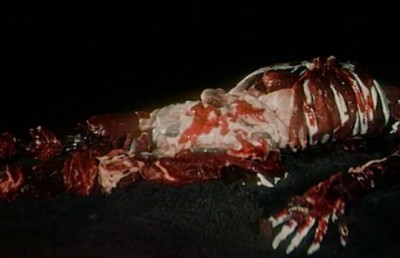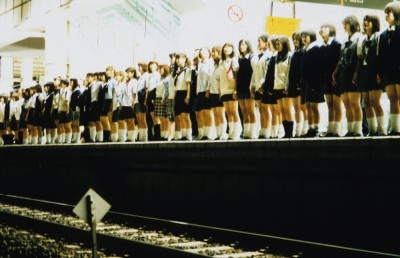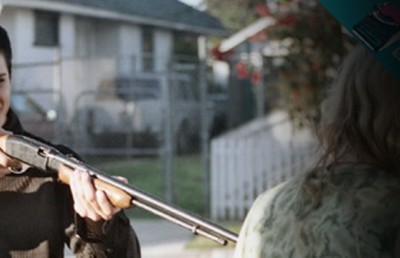Fantasia 2006: A Strange Circus Indeed
Is Style Enough?
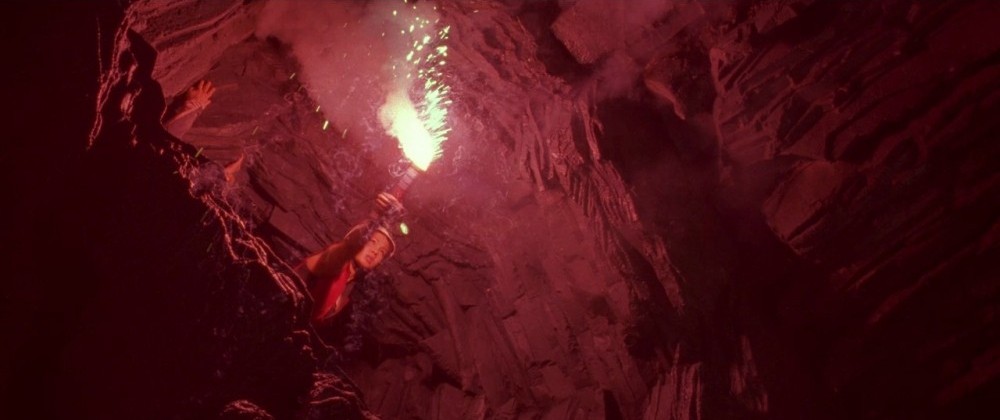
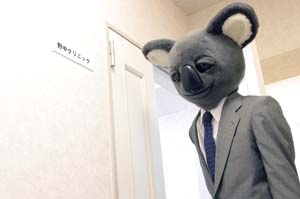
The postcards were all over town, that giant Koala head jutting out of the collar of an ordinary man’s business suit, proportionally reminiscent of South Park’s Mr. Mackey and effectively branding 2006 as year of the Koala at Fantasia. Last year we were blessed by the presence of the Calamari Wrestler, to date one of the finest screening experiences of my festival-going life. Not since the hey-day of midnight Santo screenings have I seen an audience respond the way they did to the guy in the rubber squid suit. Though the response to Koala was less enthusiastic, it was still very well received. It ended up being one of my highlights for Fantasia 2006, and the Koala was an excellent choice as mascot for this year’s festival.
Why did I like it? An eager businesskoala works hard to help a Japanese canned food company break onto the Korean market. He dashes from one important meeting to the next while sweating profusely from his furry forehead, embodying the early heart-attack candidate that has come to symbolize the unbalanced work ethic of the stereotypical Japanese salaryman. But is he under so much stress that he might actually be violently abusive to his girlfriend while remaining completely unaware of his actions? That is the question.
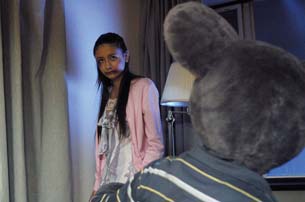
The other question is this: why is he a Koala when everyone else is a normal human? And why doesn’t anybody seem to care? Well, maybe not EVERYONE else is human. We can’t forget about his boss, a large Rabbit who is pleased with Koala’s performance and wants him to move up the ladder. He may also have something to do with the strange alternate reality that Koala seems to slip in and out of as his stress on the job increases.
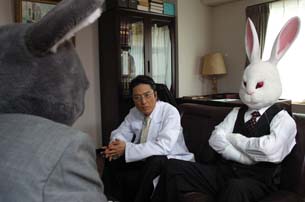
If there’s a moral here somewhere then it must hinge on this dilemma: would I like the film if it didn’t feature a guy in a Koala suit? Or is the Koala just a gimmick that carries the film through its lack of substance (at least for those of us hopelessly enamored with full-body animal costumes)? Yes, it’s probably just a gimmick with little beneath the surface of the mask. But at what point does a stylistic element slip from a justifiable aesthetic decision into the land of the gratuitous? Everyone has their line, and its position was the subject of debates some of us were having in the post-screening lobby circles when value judgments tend to fly high. Executive Koala is clearly ridiculous and must be taken as such. But what about the more serious films in the festival that could be accused of hiding a lack of substance beneath a stylistic sheen? And of all the films I enjoyed, how many of them would fall flat outside the context of the festival and the infectious enthusiasm of its dedicated audience?
One particularly heated discussion followed the French film Ils from David Moreau and Xavier Palud. One local filmmaker was outraged that the film has been so highly praised and saw it as a good example of what’s wrong with the so-called new wave of horror hitting the international scene in recent years. In his words this is a “technician’s film.” Slick, well made, and empty. Granted, I have always leaned towards the side of aesthetics when appreciating film, this thing often referred to as “form” that is, more often than not, positioned as the binary opponent to “content.” I was recently taken to task on my formalist leanings while struggling to write a review of Jeffrey Johnson’s recent book Pervert in the Pulpit: Morality in the Films of David Lynch. He argues that too much attention has been paid to the aesthetic qualities of Lynch’s work and that the staunchly conservative moral and political message of these films has been ignored. I am certainly guilty of this ignorance in my own writings on Lynch, and so I took the review process as an opportunity to think further on why I behave this way. An easy answer is that form cannot actually be separated from content, and that the two are inextricably linked. So in paying attention to one we are automatically doing justice to the other. I DO think form and content are part and parcel of the same thing, but I certainly don’t think that a critic who interprets a film based on the events that take place within the story alone does justice to the medium of film in so doing. So there is a line somewhere between the poles of form and content, and I can understand why a film like Ils would stand-out as a model for the perfection of a container without offering anything to put inside it.
So let me spoil it for you. What I love most about the film is its masterful combination of editing and cinematography which keeps the mysterious “them” of the film’s title invisible to us yet so menacingly present to the people they are tormenting in the film. It concerns a couple locked inside their house, unsuccessfully trying to prevent a group of unidentified assailants from gaining entrance. The camera moves deftly through the space, following the couple as they narrowly escape the encroaching danger from one room to the next. Doors slam shut behind them in full view but with no hint of those responsible for the action. Now we’ve all seen a million movies in which doors slam shut with nobody around. Yet the magic here lies in the fact that there is no hint of supernatural causes. The victims are clearly being harangued by human hands that are, nevertheless, kept out of view. That’s an art not easily rendered. And then, with the precision of a clockmaker, glimpses of the intruders start to appear, giving way to lingering shots of hooded figures, finally paying off with the film’s punch line: the offenders are adolescent children, responsible for many more deaths than just those presented in the events we see on screen, a situation inspired by real events. The mood of the film is perfect, the pace well measured, and the filmmaker’s know exactly how to play the revelation game that is, more often than not, flubbed to the detriment of countless films that hinge on this facet. So caught up was I in the film’s delivery that I didn’t care that it really wasn’t ABOUT anything. Is this bad?
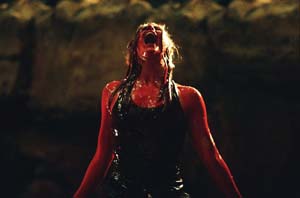
The Descent, Fantasia’s opening film this year, also came up in the aforementioned conversation as another example of a film which was deliriously well-received yet which some believe to be lacking in anything but an effective aesthetic. In this case I would tend to agree, though in many cases there was much more going on here than in Ils. At 76 minutes Ils has little pretensions towards character development, psychological motivation, or any other typical elements that drive narrative forward. The Descent, on the other hand, has a full-fledged psychoanalytical component with a 20 minute introductory segment setting up the relationships between the women who will shortly find themselves trapped in a network of caves and hunted by an evolutionary aberration living deep within the darkness. The introduction is weak, and these 20 minutes could well have been dropped to give us what would then be 79 minutes of sheer spelunker’s delight. Once inside the caves the film does exactly what it promises, and it does it well. Relying heavily on shock cuts and loud jarring sounds it is not really an exercise in subtlety and does not appeal to my usual sensibilities. It plays like a super-slick R-rated episode of Buffy the Vampire Slayer (without the snappy dialogue and reflexive irony) featuring two slayers awakening to their inner powers while the rest bite the dust –so to speak. It is certainly effective, and the crowd went nuts for it. This is a clear cut case in which I would certainly NOT have enjoyed it as much had I seen the film outside of its Fantasia context. Ils, on the other hand, would stand well on its own.
One of the very best films of the festival was a short that could also easily fall prey to accusations of employing technique at the expense of depth. The Blind Spot, from Spain’s Álex Montoya and Raúl Navarro, begins with a narrated explanation of that point in the retina where impulses exit the eye for the brain, leaving a small hole in the visual field. We don’t experience a loss of vision at this particular point in the retina because one eye, by virtue of being in a different position from its neighbor, covers that which is withheld from the other. Further, if one eye is closed then the brain fills in the blind spot by interpolating information based on that which is seen around this spot. So the concept covers two important cinematic devices: coverage and synthesis, both of which are related to the idea of the mind’s ability to construct a whole when presented with fragments. Of course coverage, when handled with continuity in mind, imposes a sense of the whole upon the viewer through the way in which it presents its fragments. Coverage is meant to cover an area so as to give us a well-rounded sense of the space being represented. The idea of synthesis, as Eisenstein figured it, is essentially the opposite: forcing the viewer to actively construct a relationship out of fragments which are not linked in spatio-temporal continuity. In both cases there are blind spots that require filling in; the difference lies in whether or not the viewer is invited to engage actively or remain passive, and it is between these two strategies that Montoya and Navarro’s film lies.
If you plan on seeing the film and enjoy a “blank slate” experience, then skip the next two paragraphs as there are spoilers ahead.
The film tells a simple story of a man on a subway train talking to a fellow commuter, explaining that he’s returning home because he fears he has left his apartment door unlocked and is afraid that a burglar might already be rummaging through his things. As soon as he says this the screen divides in two and remains split until just before the end. Immediately a set of expectations emerge. In a situation of cross-cutting the events portrayed are often presented as taking place simultaneously. Split-screen strategies, more often than not, are used as a kind of hyper-crosscutting, enhancing the feeling of simultaneity by presenting the parallel actions together rather than alternating from one to the other. One can see this split-screen simultaneity taken to its extremes in Run Lola Run, where we get coverage of the same event from different angles presented at the same time. This is taken one step further in Roger Avery’s Rules of Attraction, where a split screen joins at the end of a scene, both cameras having arrived at the same point in space and time so that they can blend seamlessly together to suture the fractured shot. With myriad other possible examples in mind, Blind Spot plays upon our desire to understand the relationship between the two halves of the screen as being one of contemporaneous action.
At first the right half of the screen presents us with a series of literal POV shots, showing the viewer’s arms outstretched in front of the camera rifling through what we assume is the worried man’s apartment. It seems that we’re seeing the perspective of the burglar that the man is concerned about. While still on the train, we watch the left side of the screen as the man approaches a young woman, enticing her to come back to his apartment with him. What we likely don’t realize is that these POV shots on the right come from later in the story when the man has dropped a girl off at his place, telling her to get comfortable while he runs out for some cigarettes. As we continue to see POV shots moving through the apartment, the other half of the screen catches up, and we watch the woman fiddling with the apartment door, trying to get it open. But the plot thickens. On the POV screen we start to see evidence that the man who lives there is some variety of maniac, with surgical tools all over and sacks of human body parts in the sink. We see the woman get the door open, and the sound of this seems to cause a reaction on the POV track as the hand picks up a knife. Here we might assume that the burglar we’ve been watching, now horrified, intends to defend him/herself against this maniac who has presumably just opened the door. There is a moment of great suspense as we await the action presented on both screens to become one, and it is right at this moment when the game is revealed: we are shown both the woman and the man, each entering the apartment at different times on their respective sides of the screen, and thus it becomes clear that the two screens are not contemporaneous after all. It has been the woman on the right side of the screen this whole time, rummaging through the apartment and who is now wielding the knife. She promptly puts it through the man’s eye, reducing his stereoscopic vision to a single spot before he collapses and expires. The split screen disappears, though a remnant of the dividing line remains in the shot as a function of creative lighting.
This film’s narrative depends on the way that the eye is guided between the two sides of the screen and pieces various points together. Initially the task seems to be to understand the relationship between actions in two different points in space, which feels easy enough if we believe the POV shots to be those of a third party in the man’s apartment while he is riding the train. What the film withholds until the end is that we should also be seeking to understand a relationship between different points in time, a task not so easily undertaken. Blind Spot is one of those films which, like Gaspar Noé’s Irreversible, causes me to question if it would be any good were the story to be told straight up with no clever cinematic devices. But in the end couldn’t we ask the same of any film? Any story can be told in an interesting way or in a dull way. It seems to me that HOW the story is told is easily of equal importance to the story itself, and in some cases much more so. So perhaps there is life yet for the “technician’s film.”
Blind Spot was part of a very strong Small Gauge Trauma program this year. The only issue I had with the program was that, after a string of excellent films presented on 35 mm, it ended with the 30 minute Ancient Rite of Corey McGillis (Dalibor Backovic). This posed two major problems. First, it was shown on video, and the projection facilities in the Hall Theatre are such that even top notch HD tapes end up filling about a quarter of the available viewing area, a tiny rectangle floating in the center of one of the largest screens in Montreal. There’s no masking available, so attention is drawn to how little the image is in comparison to what it could be. Further, the quality of the projection itself, even on HD material, is weak. The material always looks dead and washed out. If Concordia had video projection facilities on par with our local Ex-Centris complex then that would be one thing. But they don’t, and can’t possibly afford to make such an upgrade. Given this fact, if it weren’t for the reality that many filmmakers don’t have the budget to strike 35 mm prints of their work, I would be heavily in favour of Fantasia eliminating all video screenings from their line-up. This may sound elitist, or purist, or any other number of explicatives, but when you throw a video on that screen right after watching a widescreen film on 35 mm, you might as well just get up and leave because it can only be pale in comparison. I challenge anyone, film aficionado or not, to disagree with me.
The other problem with using Ancient Rite as the closing film is that the film itself really didn’t measure up to what came before. Luis Berdejo and Jorge C. Dorado’s La Guerra depicted a stark vision of a young boy hiding his little brother in a closet while trying to escape a Nazi soldier in WWII; Enrique Arraya’s harrowing The Other American Dream had us watch as though from a police video camera as a corrupt Mexican cop abuses a prostitute on his way to selling her to a depraved Texan snuff pornographer. Following works like these, Ancient Rite, with a sensibility that the catalog aligns with EC-Comics and Creepshow, just seemed silly. It probably deserved better, and would have been well placed early in the program before we got to the heavy stuff.
I was surprised about this programming choice, since usually the Fantasia crew find a very nice balance to the flow of the short programs. It was probably just a glitch, and not a big enough one to detract from the overall excellence of this edition of Small Gauge Trauma which, in turn, rounded out a nice series of short programs that once again demonstrated Fantasia’s commitment to short format cinema. So it was fitting that the festival has finally spawned the first volume of a short-film compilation disc. Released by Synapse Films, the Small Gauge Trauma DVD features some of the best films to be shown in this program since 1998, including one of my all-time favourite entries: Love From Mother Only by Brazil’s Dennison Ramalho. The production quality on the disc is excellent, boasting nice transfers with anamorphic encoding on the widescreen selections. Well worth picking up.
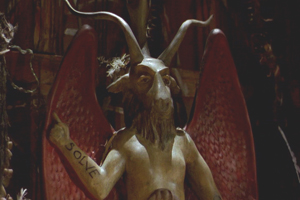
The DVD also features Robert Morgan’s The Separation, one of the UK animator’s four films shown as the Worlds of Wounded Clay program. Designed to celebrate Morgan’s amazing work, it was a fantastic opportunity to see these shorts on film. All of them are outstanding, including Monsters, his recent foray into pure live-action which clearly demonstrates his ability to expand beyond the stop-motion paradigm. My favourite, though, is The Cat with Hands, a film which charts Morgan’s shift between the two modes of filmmaking (click here to view the film on Quick Time 7). Again, the formalist in me is a sucker for the film’s structure which bookends the central animated sequence with live action. What is most interesting to me is how the line is blurred between live action and animation through the treatment of the human actors with stop-motion and other cinematographic techniques usually reserved for models and puppets. The story, concerning a cat who steals human body parts until it has become entirely human on the surface, is directly related to interspecies appropriation that can, by extension, be applied to the interchangeability of humans and their modeled likenesses.
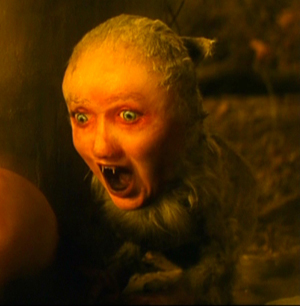
As such the film provides an interesting commentary on the relationship between live action and animation, as well as being an exemplar of the form = content approach to filmmaking. But mostly I just can’t get over the cat. I’m a died-in-the-wool feline worshiper, and when those fangs pop out beneath the cat’s newly acquired human face it’s a genuinely brilliant cinematic moment. My four cats have now seen the film a number of times. I just hope they don’t get any ideas…

The screening I was most anticipating this year was Herzog’s Wild Blue Yonder. It was odd to find him amidst the Fantasia programming, but perhaps not as odd as having a full Herzog retrospective at the festival of “New Cinema” here in Montreal a couple of years back. I certainly appreciate the chance to see his films on the big screen regardless of the mandate of whatever festival that decides to screen his work. And this film promised a great deal. As we all know, Herzog’s CV is impressive in the realms of fiction, non-fiction, and that wonderful area often thought of as being “in-between” (but which actually encompasses the entire spectrum no matter how much faith we put in the documentary mode’s ability to show us something of reality). With Wild Blue Yonder, Herzog was to blur the boundaries further than he had ever done previously, boasting that he wanted “to use imagery and sound in a way you have never before experienced” (Fantasia Catalog 2006). One should never say never, and when the bar is set as high as that one is likely to be disappointed. And so I was disappointed.

Not that the film isn’t beautiful in its appropriation of NASA shuttle footage and documentation of Arctic diving expeditions to construct a tale of an interstellar journey to a distant planet known as the Wild Blue Yonder. But using voice-over narration to recontextualize documentary footage set to a musical score (however eclectic and unusual) is hardly a new approach to filmmaking. Mind you, I’m not particularly keen on the idea of originality for its own sake, and am perfectly happy if someone works within an established genre and does it well. What really bothered me about this film was Brad Dourif playing a disenfranchised alien living in an abandoned southern California town, acting as narrator for the tale of what the journey to Earth and his home world entails. Herzog spends a great deal of time on Dourif himself as he putters about the tumbleweeds, musing about all manner of conspiratorial theories. I generally like Dourif, but felt like he was lending an insincere quality to the proceedings here. While it was interesting to hear him announce the greatest sins perpetrated by human beings during the 500 generation journey from Wild Blue Yonder to Earth –among them the domestication of the pig and mountain climbing as a recreational activity– his comedic tone detracted from the mesmerizing quality of Herzog’s treatment of the documentary footage. There were certainly some great moments of interplay between Dourif’s scripted banter and information given by what is assumed to be unscripted interviews with scientists, prompting us to wonder which came first, and who was feeding off whom. Ultimately, though, I would have been happier with a less verbocentric version of the film, or at least a more somber mood. But that is unquestionably a matter of opinion.
The most beautiful part of the film comes as we watch divers below the Arctic ice, moving up towards a hole through which blinding light pours. The narration explains that what we’re seeing are the Yonder natives floating up towards a portal in the sky. As they pass through they are broken into particles of light to be reassembled on the other side. So our sense of the ice as being earthbound is transformed into seeing it as the sky, a wonderfully simple but effective example of the power to shift figure and ground through a simple adjustment of perspective. The intense overexposure of the light coming through the hole works perfectly to make it seem as though the divers are being obliterated as they move through it; the intense bubbles of air that flurry around them, combined with a thick film grain from the fast stock used for the dark underwater photography, creates the particles of light into which these beings are transforming. It really is a fantastic cinematic moment, and makes the film well worthwhile for me.
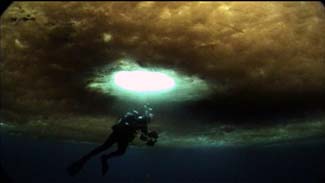
Another highlight was a rare screening of Donald Cammell’s White of the Eye, which was apparently very hard to get a print of and which hadn’t been seen in many moons. It looked fantastic, and I got very excited when I discovered the main character works as a custom stereo system installer. I too, until very recently, was working at a local high-end shop doing home theatre installations. Unfortunately that aspect of the character didn’t really amount to much. Aside from the fact that it gave him a legitimate reason to access people’s dwellings, the job didn’t really seem important to his character. But the film as a whole was a real eye-opener when thinking about this work in relation to Cammell’s interesting career. To help put the whole thing into context the screening coincided with the book launch for Donald Cammell: A Life on the Wild Side published by FAB Press. Authors Sam and Rebecca Umland were in attendance to give a talk about both the film and Cammell in general. It was a special evening, and as the lights dimmed a serious fan close by was heard to say: “I can’t believe this is really happening!”
In the end though, my pick of the litter has to be Strange Circus, the second film from Japan’s Sion Sono, a name made famous in Montreal when his debut Suicide Club played Fantasia in 2003 (click here for an interview with Sion Sono). If ever there was film that needed to be seen more than once before trying to talk about it, this is it. But I’ll give it a whirl anyway. A more visually stunning film I’ll be unlikely to see anytime soon; Sono’s eye for colour is nothing short of astonishing. And the density of his production design is matched by the layering of his narrative, revolving around the memories of a woman who was made to watch her parents having sex while she was an adolescent, a role she soon traded with her mother. What elevates these disturbing scenes from sheer depravity, and which prevents the film from being dismissed as yet another Japanese fetishization of school girls as sexual objects, is that fact that we never actually see the adolescent engaging in the sex act with her father. Whenever we are meant to understand that he is sleeping with his daughter, the shot/reverse shot relations between the two parties in bed are cut so that we see shots of the mother where the daughter should be. This simple but effective strategy sets the stage for a complex psychoanalytical journey through the young woman’s obsession over whether or not she is growing to resemble her mother, and what that might mean in terms of the father’s desire for them both. The identities of mother and daughter become increasingly confused as the film allows free slippage between different planes of reality. This slippage culminates with a scene involving the mother falling down some stairs, becoming injured, and requiring replacement by the daughter. This scene is then repeated shortly after with the roles reversed. The fall itself stemmed from a physical confrontation between the two women when the mother discovered that her daughter was wearing her earrings. Mom beats her severely while trying to take the jewelry back. The act of the daughter wearing the mother’s clothes signals the identity transference that drives the film’s simultaneously co-existing planes. The severe beating administered by the mother indicates that it is she, not her husband, who is truly responsible for abusing their daughter. In the end we never see the father touch the daughter either violently or sexually, and so the suggestions made of the father’s abusive position are called into question. I don’t remember any answers being given to this question, and surely he’s not without guilt. But the film’s deft hand at guiding us through bizarre folds of reality (along with a host of depravities thrown in liberally throughout) make for a rather singular cinematic experience.
The fact that I had the opportunity to see a film like this on 35 mm is testimony to the value of the film festival experience. The joys are fleeting and are continually frustrated by the necessity of too many films in too little time; but I’ve never regretted it. I wish the same for you.



